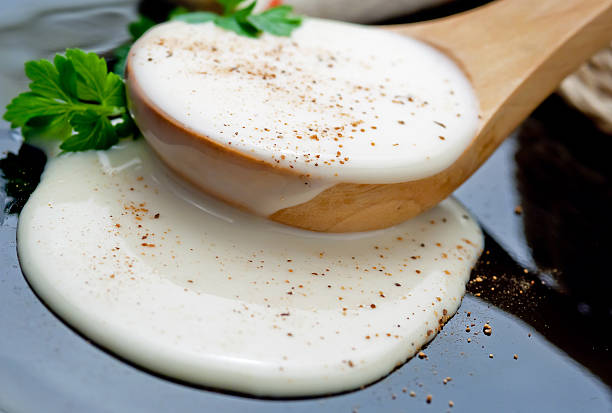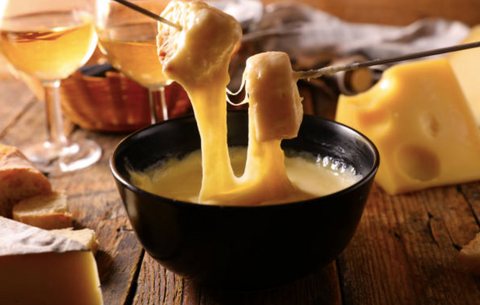Bechamel sauce, also known as white sauce, is one of the mother sauces of French cuisine and is used in many recipes of Italian cuisine, for example, lasagne. In addition, it is used as the base for other sauces (such as Mornay sauce, Béchamel with cheese). In Italian, it is called besciamella or salsa colla.
This sauce is commonly made by blending a roux and milk. The roux is traditionally made by browning flour in melted butter but can also be made using oil instead. In Portuguese cuisine, a similar recipe called molho Branco ("white sauce") is often prepared with wheat flour and chicken broth instead of milk. Bechamel was already known to Bernardino de Sahagún when he wrote about Aztec food in 1529.
Difference between bechamel Sauce and Alfredo Sauce
- Béchamel Sauce
Béchamel sauce is made by melting butter and flour together before adding milk. The classic recipe calls for a roux or a mixture of equal parts fat and flour. However, some recipes use less butter and more flour for a thicker sauce. In any case, you cook the ingredients until the raw taste of the flour is cooked out and the milk is thickened.
- Alfredo Sauce
Alfredo sauce is similar to béchamel, but it uses cream rather than milk as its base. This gives Alfredo sauce its famously rich texture and a higher calorie count than béchamel. Alfredo sauce also has Parmesan cheese added to it. Sometimes garlic is added, too, but it sit is not necessary.
How they’re Different
Besides using different bases, béchamel and Alfredo sauces differ in their applications. Béchamel is the base for many other sauces, including Mornay sauce, which is just béchamel with cheese, added to it. It is also often used in lasagna and other baked dishes like gratins because it holds up well under high heat. Alfredo sauce, on the other hand, is usually served.
Purpose of Bechamel Sauce
Bechamel sauce aims to provide a relatively light, creamy liquid to combine with other ingredients. The original purpose of the mother sauces was to create a solid foundation for different sauces.
While today it is most often used in lasagna, it is also used in other dishes like moussaka, cauliflower cheese, broccoli cheese, and Welsh rarebit.
Béchamel sauce, also known as white sauce, is a basic white sauce. It is one of the mother sauces of French cuisine and is used in many recipes of Italian cuisine, for example, Lasagne, Alla Bolognese, and cannelloni.
Béchamel sauce is made by melting butter and then mixing it with a roux (butter and flour) mixture. Milk is added to this roux, constantly stirring with a whisk to prevent lumps from forming. The sauce is cooked until it thickens enough to coat the back of a spoon.
The thickness of the béchamel can be adjusted by changing the amount of time it cooks. A thinner béchamel can be used as a base for cream soups or sauces, while a thicker béchamel can be used as a base for gratins such as macaroni and cheese or lasagna.
Bechamel Sauce is called White Sauce
The first question we should ask ourselves is why is there a white sauce at all?
The fact of the matter is, if you look into the history of sauces and how they were used, you will find that there were two main types of sauce:
- There was a thickened sauce made with flour that was based on the idea of making something similar to a roux. It was always a base for other sauces and flavors.
- A thinned sauce made with stock was used to flavor soups and gravies.
Now, what did these two types of sauces have in common? First, they were both clear, which meant that they would not interfere with the color or appearance of the dish they were being served with.
Bechamel is an ancient sauce; it has been around since at least the 17th century. So what is it? It is essentially a thinned version of one of those thick sauces (one we usually make with flour) thickened with milk instead.
Is Béchamel Sauce the same as white gravy?
Béchamel is a variation of white sauce made from butter and flour. The two are not the same, however. Béchamel is typically made with warmed milk added to the roux, but the milk used can vary greatly. It can be thick or thin, making it suitable for use in soups and lasagna, and over meats.
White gravy starts with a simple roux (flour and fat) but includes drippings from meat as one of the ingredients. It also tends to have more fat than béchamel, making it richer. One of the most accessible versions to make is sausage gravy, which uses pan drippings from cooked sausage and some milk to create an instant sauce over biscuits or toast.
The critical difference between these two sauces is the amount of liquid used in each one. Béchamel needs more liquid to make it pourable, while white gravy usually has less liquid in it to stick better to whatever is being served under it.
Taste of the Béchamel Sauce
The flavor of béchamel is rather bland, and the texture is smooth and creamy. You can add other flavors to this sauce, such as nutmeg, herbs, or cheese. Some people like to add garlic to it.
Béchamel is often used in some classic dishes, such as lasagna and macaroni and cheese. It is also used for soufflés, gratins and casseroles.
If you enjoy making your pasta sauces, try a béchamel recipe at home. You may be surprised at how easy it is to make this flavorful sauce!
The sauce tends to hide the flavors of other ingredients. That's why many people think that gratins taste bland — it is simply an effect of the sauce. If you're serving a gratin, add plenty of spices and herbs to compensate for the béchamel.

What dishes use Béchamel Sauce?
Béchamel sauce, one of the most famous French sauces and five mother sauces, is a staple ingredient in many recipes. It is so versatile that you can use it as a base for soups, pasta dishes, casseroles, and even desserts!
Here are some of our favorite ways to use béchamel sauce in all kinds of dishes:
- Lasagna
- Creamed spinach casserole
- Macaroni and cheese
- Shrimp scampi pasta
- Scalloped potatoes
- Fish pie
Béchamel sauce is a white sauce that is used in many dishes.
Béchamel sauce can be used as a base for other sauces, such as Mornay or mustard, by simply adding cheese or seasonings. It can also be used to make more complex sauces, such as soubise (onion-flavored), crème (thickened with egg yolks), or Nantua (with crayfish butter). It is often the base for soups such as onion soup gratinée and leek and potato soup.
In addition to its use as a base for soups and other sauces, béchamel is also used in many casseroles, such as lasagna, macaroni and cheese, scalloped potatoes, and chicken divan. Béchamel is also used in several different kinds of quiches and savory pies.
Serving béchamel by itself is a popular way to make it into a side dish: cook the sauce until it becomes thicker than usual, and then remove it from the heat before adding any cheese or other flavorings.
Difference between a Roux and a Béchamel
A roux is a cooked paste of flour and fat (butter, oil, lard, shortening) used to thicken sauces and other liquid mixtures like stews and soups. A béchamel sauce is a special sauce that whisks a hot roux into milk.
Roux is French for "red," which refers to the color when you cook the flour before adding it to your liquid. The longer the roux cooks, the darker it gets — and the less thickening power it has. That's because starches burn once they reach a specific temperature, causing them to break down. So, in general, you want to cook your roux only until it reaches its desired color (from blond to dark brown), then add your liquid.
Béchamel sauce is also known as a white sauce or cream sauce (even though it is not made with cream). It is typically caused by adding hot milk to a blond roux (cooked just long enough to remove the raw flavor of the flour). It can be thin or thick depending on how much roux you use — which itself depends on what you're doing with the finished sauce. For example, béchamel is one of three parts.
Can you freeze Bechamel Sauce?
There are lots of reasons you might want to freeze bechamel sauce. You can buy a big bag of flour or a box of pasta, but you can buy a good-quality package of bechamel. Instead, you can make a big batch and freeze some for later use.
Yes, you can freeze bechamel sauce. I recommend you freeze it in ice cube trays and then transfer the cubes to a freezer bag or container. Then you can easily pop out just the amount of bechamel you need for each recipe.
When you want to use your frozen bechamel, remove the cubes from the freezer bag or container and place them in a pan over low heat. Stir frequently as the cubes thaw, keeping them from clumping up as they melt.
Once all the cubes have melted, stir until smooth and creamy your bechamel.
Bechamel Sauce with Cheese
You can use almost any kind of cheese in a Bechamel or Mornay. Still, you'd be wise to avoid very strong-flavored cheeses like Roquefort or the Bechamel won’t taste like anything but cheese, not that there's anything wrong with that sauce.
Bechamel sauce is popularly known as white sauce. It is a milk-based sauce. However, you can make it with water if you don't have milk. The only difference will be in the taste. Milk has a rich and creamy taste that adds flavor to the sauce.
There are different Bechamel sauces, each with its unique flavor and taste.
- The first type of Bechamel sauce is made from butter and flour. You can add garlic or onions to this simple recipe and make it even more flavorful.
- The second type of white sauce is made with butter, flour, milk, cheese, and some spices like nutmeg or mustard paste. This is the most common white sauce used in pasta dishes such as chicken Alfredo, macaroni and cheese, etc.
- The third type of white sauce is made with butter, flour, and heavy cream without cheese or milk.
You can use any cheese in this basic bechamel recipe except feta cheese because it has too much moisture content (which will make your white sauce more liquid). For example, parmesan cheese has been aged for at least 3 months before using it in your dish, so if you want something…
Béchamel Sauce uses
Béchamel sauce is one of the five mother sauces in French cuisine and is used as the base for other sauces (such as Mornay sauce), soups, gratins, and casseroles. It is typically made by melting butter, adding flour to make a roux, and then cooking with milk.
Béchamel sauce is traditionally served with white asparagus and potatoes. It can be used in lasagne and Greek pastitsio. In Greece, it is commonly used on baked meatballs (keftedes). In Italy, it is a critical ingredient in Neapolitan ragù. In Poland, the dish is known as placki ziemniaczane ("potato pancakes"") used as a topping along with cheese or ketchup.
Béchamel can be used in quiches and gratins to bind ingredients together and thicken the dish. Some restaurants will use béchamel to give body to cream-based soups. The sauce can also cook vegetables such as broccoli or cauliflower. It can also be used as the base in making croquettes.
The popularity of Béchamel Sauce
The popularity of Béchamel sauce has spread far and wide, and today there are many variations on this sauce found throughout the world.
In the UK and Ireland, it is commonly used to make white sauce, generally served with cauliflower cheese, lasagne, and moussaka. It may also form part of a cheese sauce for dishes such as macaroni cheese.




